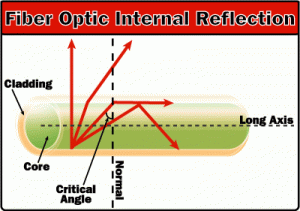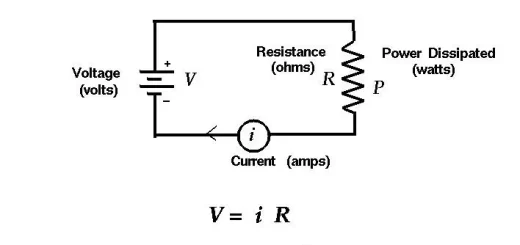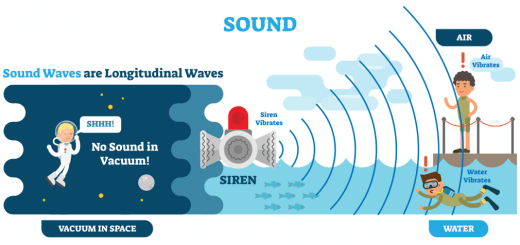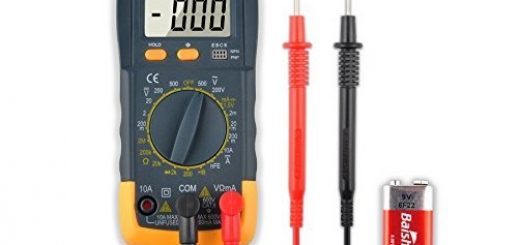Applications on the total reflection of light (Optical fibers, Reflecting prism & Mirage)
Light refraction is used in explaining total reflection and dispersion of white light , When a light ray travels from an optically higher dense medium ( such as water ) to an optically less dense one ( such as air ) , it refracts away from the normal line , As the angle of incidence increases in the optically higher dense medium , the angle of refraction increases in the optically less dense one .
Total reflection
At a certain angle of incidence , the angle of refraction reaches its maximum value , which is 90° and the light emerges tangent to the separating surface and is called in this case grazing ray , the angle of incidence is called the critical angle ( Φc ) .
When the angle of incidence exceeds the value of the critical angle , the light ray does not emerge to the optically less dense medium but reflects totally in the optically higher dense medium and this phenomenon is called total reflection .
Critical angle between two media ( Φc ) is the angle of incidence in the optically higher dense medium , which corresponds to an angle of reflection in the less dense medium equals 90° .
Total reflection is the reflection of the light rays in the optically higher dense medium when the angle of incidence exceeds the critical angle of the optically higher dense medium .
When the critical angle of a medium with air = 40° , This means that the angle of incidence in this medium = 40° , corresponds an angle of refraction in air = 90° .
Conditions of the total reflection
- The light rays travels from the optically higher dense medium to the optically less dense one .
- The angle of incidence must exceed the critical angle between the two media .
Deduction of the relation between the sine of the critical angle & the refractive index of a medium
Applying Snell’s law :
n1 sin Φ = n2 sin Θ
Φ = Φc , Θ = 90°
∴ n1 sin Φc = n2 sin 90°
sin Φc = n2 / n1 = 1n2
Where ( n ) is the absolute refractive index of the optically higher dense medium .
Applications on the total reflection of light
- Optical fibers ( fiberoptics ) .
- The reflecting prism .
- The mirage .
Optical fibers ( fiberoptics )
Optical fiber is a thread-like tube of transparent elastic material , which can be bent while containing light and can be made of a bundle of fibers .
When a light ray falls on any part of the internal wall of the optical fiber with an angle of incidence greater than the critical angle , it undergoes successive multiple reflections until it emerges from the other end without much losses in the intensity of light despite of the bending of the fiber .
Optical fiber is a thread like tube of transparent elastic material in which the light ray enters from one end and undergoes successive multiple reflections until it emerges from the other end .
Optical fibers uses
- Transferring light to parts hard to reach .
- Transmitting light in non-straight paths without much losses in the light intensity .
- They are widely used nowadays in medical examination such as medical endoscope , which is used in diagnoses and operative surgery using laser beam .
- Communication as light can carry millions of electric signals in optical fiber cables .
Reflecting prism
Reflecting glass prism whose angles ( 45° , 45° , 90° ) , It can change the path of light beam by 90° or 180° , So , it is used in some optical instruments such as periscope in submarines and binocular in the field .
Changing the path of the light ray by 90° : When a light ray falls normally on one of the right-angled sides , it passes straight and falls on the side opposite to the right angle 45° .
Since the critical angle between the glass and the air is 42° then , the light ray reflects totally by an angle 45° , The reflected light ray falls normally on the other right-angled side and passes without reflection .
Changing the path of the light ray by 180° : When a light ray falls normally on the side opposite to the right angle , it passes straight and falls on one of the right-angled sides by an angle 45° , Since the critical angle between the glass and the air is 42° , then the light ray reflects totally by an angle 45°.
The reflected light ray falls on the other right-angled side by an angle 45° and reflects by an angle 45° , The reflected light ray falls normally on the side opposite to the right angle and passes without refraction .
The reflecting prisms are preferred than the metallic reflecting surface ( mirror ) in some optical instruments because they reflect light totally while it is seldom to find a metallic reflecting surface whose efficiency is 100 % , In addition , a metallic surface eventually loses its luster & hence its ability of reflection decreases , This does not happen in a prism .
The surfaces at which light rays fall on a prism or emerge from it may be coated with non-reflective layer of material like cryolite ( aluminium fluoride & magnesium fluoride ) whose refractive index is less than that of glass , Thus , the critical angle between the glass & cryolite becomes small to avoid any reflection losses on the prism , even little as they are .
Mirage
During hot days the roads seem covered with water , also the hills and the palms seem as inverted pictures such as the picture formed due to reflection on water surface , So , the observer thinks that there were water on the road and this phenomenon is known as mirage .
In extremely hot days , the temperature of air layers adjacent to the Earth’s surface increases , so that its density decreases more than the upper layers , Accordingly the refractive indices of the upper layers become more than the lower layers ( n1 > n2 ) .
When a light ray passes from the upper air layers to the lower air layers , it refracts away from the normal according to Snell’s law , where ( n1 sin Φ = n2 sin Θ ) , The deviation of light ray increases when it passes through air layers taking a curved path .
When the angle of incidence of the light ray in one layer become more than the critical angle of the following layer , the light ray reflects totally taking curved path upwards until reaching the eye , so , the eye sees the image ( top of the palm ) inverted on the extension of the light rays that reach the eye and the observer thinks that there is a pond .
Dispersion of White light analysis, Normal prism and thin prism
Light waves properties, Analysis of white light, Spectrum colours & Light intensity
Types & Laws of light reflection, Regular & Irregular reflection of light
Light refraction effects, Law of light refraction, Mirage & Apparent positions of objects




